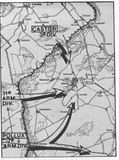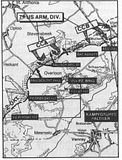Battle for OverloonThis battle is not well known because the amount of forces was limited but it was still a bloody and costly fight. Not much info can be found so here's a resume.
IntroductionSeptember 1944 Monty launched Market Garden.
Dempseys 2nd Army has created a corridor between the German lines from Hasselt to Eindhoven effectively cutting the German force in two parts.
A strong kampfgruppe, Panzerbrigade 107 commanded by major Freiherr von Maltzahn, was left behind near the Maas river between Sambeek and Venlo.
They were positioned in very good defensive positions, allied forces couldn't use their armor effectively because of the rural terrain.
Pz Brigade 107 cut through the corridor at Veghel 2 days after the start of Market Garden and was a menace to the 101st airborne division.
(
see my CMAKscenario Kampfgruppe Walther)
September 25th Market Garden turned into a complete failure.
The Germans weren't beaten and a large part of the Netherlands had to wait for its liberation until May 1945 with a very cold 44-45 winter where thousands of Dutch civilians died of cold and hunger.
The terrain the Germans choose to defend the west side of the Maas river stretches from Oploo to Blerick (Venlo).
This terrain is formed by swamps, wet graslands, soft ground and creeks with large sections of woods.
There was only 1 road for heavy traffic leading from Oploo to Venray.
First fightingsAfter breaking through at Veghel and the actions at Son (US 101 Ab) the German 107th bigade retreated to the forests at the Rips. (halfway Deurne and Oploo)
They were surprised to find out the British army already took Gemert and Deurne on the 24th.
To avoid encirclement the brigade moved out in a hurry to get to Oploo and Overloon before the British army closed the gap.
The Germans managed to reach Overloon and on sunday the 25th they formed a defensive line in the area of Overloon.
On that same day the first elements of a major British unit (11th armored division) "Black Bulls" reached Oploo.
Due to a lack of supplies they couldn't move any further and got stuck at 8 km from Overloon.
On september 26th a British infantrybatallion tried to take Westerbeek but the Germans were prepared and waiting at Overloon and Stevensbeek (Peel and Heikant).
From that moment the center of combat layed at both sides of the road to Oploo.
The BeginningIn the night of the 26-27th the British artillery focused on Overloon, their main objective, the churchtower which provided a clear view of the area.
The church got hit and the few Germans sleeping inside were killed.
The civilian population was hit severe and the Germans ordered them to leave the area. The next morning more than 3000 people from the surrounding villages and Overloon itself were evacuated.
Meanwhile Montgomery was working on his plan to attack the Rhineland (Rühr) but before the allies could launch this operation the German bridgehead at Overloon had to be destroyed.
The British 8th army first recieved the order to attack but its commander refused to attack because a large part of his division was ordered to participate in the upcoming attack on the Rhineland.
Therefore the US 7th armored division got the task to clear Overloon. The 7th was ordered to move from Metz and it arrived after two days of forced marches. Their main target was Venlo.
Allied Intelligence was poor and said that German opposition would be badly organized and mainly existed of old men and young boys. All this proved wrong, the German commander was much better prepared.
CCA, US 7th armorSeptember 30 1944 0600
Shermans advance towards the German positions.
Line of attack was Vortum-Mullen, Brakkenhof, Stevensbeek and the road to Oploo.
CCA advances towards 'Overloonse vlak' and CCB attacks Vortum.
CCA soon finds out it wasn't dealing with old men but veterans of the 107th brigade with 88 mm's and Panthers.
The Germans launched a fierce counterattack, the Americans had to retreat.
The attack was resumed October 1st but this time the Germans managed to drive the Americans back again due to heavy artillery fire and relentless counterattacks.
The terrain favoured the Germans and due to their experience in combined arms and delaying actions they hit the US division hard, time after time again.
The next day the RAF and USAF attacked the German positions but weren't able to strike hard due to the cover of trees.
Panthers, 88's, nebelwerfers and PaK 40's caused a high toll amongst the US Sherman tanks.
On the 3rd General Hasbrouck ordered CCA to attack at night.
He split his force and tried to attack from two directions, both attempts failed because his tanks drove into German minefields.
German counterattacks drove the US forces back each time. By October 4th the US commander reported 7 counterattacks.
Hasbrouck decided to send an infantrybatallion with tanks to Vierlingbeekse Heide and Vierlingbeekse Broek to encircle Overloon.
Due to the lack of recon the Americans failed to recognize Hattert castle which hosted Luftwaffe Flakfestungs batallion X with their 88s.
Within a few seconds 10 tanks were destroyed, the RAF attacked the castle but it was too late, the attack itself failed and was aborted.
For the next days nothing changed, the coming 3 days the Americans attacked and the Germans counterattacked, at some places the infantry got close to 50m from eachother lines.
October 8th the US division was relaeased by the UK 11th tankdivision. They lost 35 Shermans.
The German bridgehead at Venlo was still intact with the front moving only 1 km.
The only advantage for the allies was that they now had control over the forests at Stevensbeek.

 Operation Constellation
Operation ConstellationThe bridgehead at Venlo was still intact, therefore the allied command came up with a new plan to destroy it.
Operation Constellation consisted of 4 phases.
*Phase 1 is named Castor.
Attack and occupy the area Overloon-Venray by the 3rd UK infantrydivision.
This division had the task to tie down as many German units as she could.
The Germans were to believe this was the main axis of attack.
When everything went as planned the other 3 phaseds were to be carried out.
*Phase 2 (Pollux) US 7th armour through Deurne attacking towards Venray.
*Phase 3/4 (Sirius and Vega) British 11th armor attacking with 15th Infantrydivision in the direction of Venlo and Roermond to cut of a posiible German retreat.
This article only deals with Phase 1.
Phase 1 Castor, the attack at OverloonThe attack was scheduled for October 11th.
General-Major Whistlers 3rd division supported by Flail tanks and by 2 batallions of the 6th Guards brigade with Churchilltanks got the order. This brigade was still at Mook and it took them 4 days to travel the 25 km to the starting point. Heavy rains changed the ground into thick mud. The attack was delayed with 24 hours. Another setback was caused by not destroying the bridges at Roermond and Venlo.
Allied HQ decided they needed these bridges intact knowing very well they provided the Germans a way to resupply and bring in reinforcements.
This decision caused much losses among the allied troops that could have been avoided.
On 12 october the final attack is launched (fighting had been going on for almost two weeks)
200 allied guns positioned near St Antonis, Oploo, Stevensbeek and De Rips opened fire.
In 90 minutes thousands of shells fall down on Overloon, reports claimed a number of 25000 to 100000 shells.
Many civilians died in this inferno.
Venray was bombed twice to cut of German resupplying efforts.
At 12.15 in the afternoon Overloon has changed into a ruine, 2 infantrybatallions charged supported by tanks.
On the west axis 1st infantrybatallion Suffolk supported by two companies of Churchils from 6th guards.
On the eastern axis 2nd infantrybatallion Eastern Yorkshire supported by two companies Churchills too.
They advanced 1,5 km in the first hour, but the closer they get to the German lines, the harder the Germans fought.
The Churchills werent able to leave the roads, mines and PAKs supported by scattered 88's caused lots of casualties.
But the advance went on, once the allied troops reached the city they got involved in heavy streetfightings.
The first groups German soldiers surrendered, but elsewhere many kept fighting.
In the centre of the town SS men kept resisting.At 1500 the reserve bn from 8th brigade was ordered to join the fight.
1st infantrybatallion South lancashire,.
They had to protect the flanks supported by 1 company Churchilltanks.
During the evening they reached the forests west of Overloon, at that time most of Overloon was occupied by the British units.
The 107th brigade retreats to the forests behind Overloon and Venray and dug in.
From there they had to conduct counterattacks against British units trying to cross the small river Loobeek.
The 13th early in the morning the allied drive was resumed.
They met tough resistance everywhere, they moved slowly forward but with heavy losses.
In the forests and in the old citycentre of Overloon fanatical SS men charged everywhere, some only with their shovels and bajonets.
The German paratroopers on the other flank were driven back to, losses among the Panthers grew too because the British soldiers could get close to them.
Finally the pressure became to much for the Germans, their overall commander Oberst Goltzsch decided to retreat behind the Loobeek.
The Germans layed many mines in the area.
On the 14th a heavy bombardment with fosforboms broke the last German forces around Overloon, a few scattered positions left bu these were destroyed quickley.
Late in the afternoon Overloon and the area around it is in allied hands.
LossesDuring the battle for Overloon the americans lost 452 men, 35 tanks, 2 planes and 43 other vehicles.
The British troops lost 20 tanks and 1 plane but because they had to cross the heavily fortified Loobeek to reach venray they lost 1426 men.
The German losses were estimated by the allies. over 600 soldiers and 10 tanks.(Panthers)
The brigade was taken back to germany and transferred to the 25th panzergrenadierdivision.
AfterwordAfter the Market Garden failure the allied forces had to keep the Nijmegen corridor open.
Therefor the German bridgehead at Venlo had to be destroyed.
The allied forces suffered heavy losses after taking Overloon, they lost a lot of men at the Loobeek and during the advance to venray.
But after Venray was taken the allied advance was stopped, the troops were needed to take Antwerp and the rest of Brabant.
Therefore Overloon was a costly price.
July 31st 1945 a foundation was raised to preserve vehicles and equipment in order to commemorate the battle.
Guns and vehicles were towed away in a wooden barn, this was the start of the natioanal war and resistance museum Overloon.
May 26th 1946 the museum was officially opened by General Whistler.
In the following years the collection grew (with the implementation of the Marshall museum collection)
The battle still lives on in Overloon!
Info about the museum, official website in English:
OorlogsmuseumSources: maps by Rocking Harry, article published (dutch) in the Stoottroepen magazine named Strijdend Nederland.











